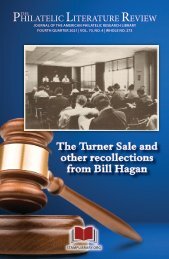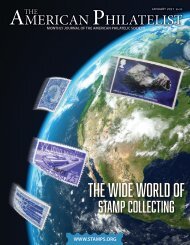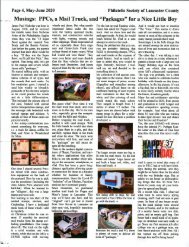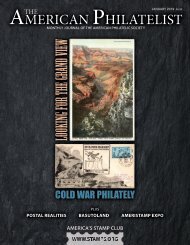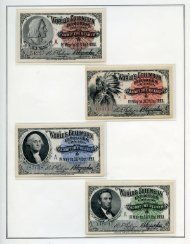August 2018 - Sneak Peek
The American Philatelist is the monthly journal of the American Philatelic Society, the world's largest organization for stamp collectors and enthusiasts. Members receive the printed magazine and can access the digital edition as a benefit of membership in the Society. Please enjoy this sneak peek. We're confident that once you see all that we offer, you'll want to join the APS today.
The American Philatelist is the monthly journal of the American Philatelic Society, the world's largest organization for stamp collectors and enthusiasts. Members receive the printed magazine and can access the digital edition as a benefit of membership in the Society. Please enjoy this sneak peek. We're confident that once you see all that we offer, you'll want to join the APS today.
You also want an ePaper? Increase the reach of your titles
YUMPU automatically turns print PDFs into web optimized ePapers that Google loves.
Joe Alves, production designer and location scout for<br />
Stephen Spielberg’s movie, Close Encounters of the Third Kind<br />
(1977), said the choice of Devils Tower as the site of the film’s<br />
climactic alien encounter was significant, according to an article<br />
on the Travel Wyoming website (www.travelwyoming.<br />
com/devils-tower-landmark).<br />
“ ‘I’ve been fortunate to work on a lot of films and scout<br />
a lot of places in the world. I don’t think there’s any singular<br />
place like Devils Tower,’ ” said Alves in the Travel Wyoming<br />
article. The article continues, “Spielberg, who both wrote and<br />
directed Close Encounters, sent Joe out to find ‘an unusual<br />
piece of topography’ for the film. He visited several unique<br />
landmarks, as far away as India, but Devils Tower stood out<br />
among them all. ‘Nothing that I had seen, whether you go to<br />
Zion or Bryce … nothing comes close to seeing this thing.<br />
This incredible shape,’ ” Alves said. “He explains. Spielberg<br />
shared Joe’s enthusiasm. ‘When he got here he was so taken by<br />
the possibilities of what this would do to his film,’ Joe recalls.<br />
“It wasn’t until later in the process that Joe became aware<br />
of the spiritual significance Devils Tower has in the American<br />
Indian community. ‘We just liked the shape of it and then<br />
we find out it has this incredible spiritual value,’ he reflects,<br />
and reveals that the spiritual pull of the place extends beyond<br />
the Native American stories. There’s something about this<br />
imposing rock that is powerful throughout the ages. ‘It’s so<br />
perfect because of the theme of the film, that there really may<br />
be some spiritual sense in the mountain, which just adds to<br />
the credibility of what the whole film is about. That if aliens<br />
were to come, why wouldn’t they choose a place like this?’ He<br />
ponders. ‘It heightened the creative and spiritual sense of the<br />
film which led us to make it a much bigger film.’ ”<br />
In December 2007, the film was deemed “culturally, historically<br />
or aesthetically significant” by the United States Library<br />
of Congress and selected for preservation in the National<br />
Film Registry.<br />
774 AMERICAN PHILATELIST / AUGUST <strong>2018</strong>





